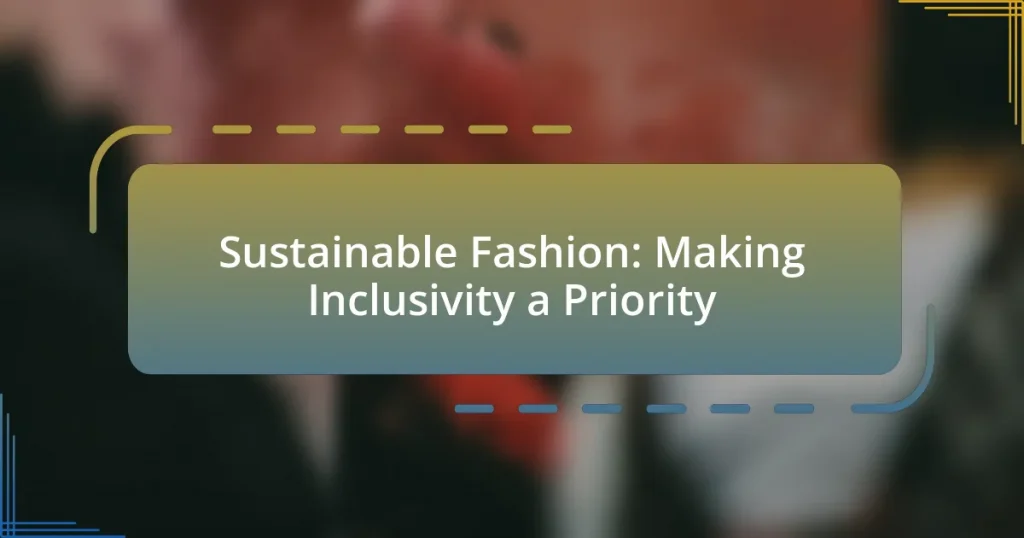Sustainable fashion is an approach in the clothing industry that emphasizes environmental and social responsibility throughout a garment’s lifecycle. Inclusivity is a critical aspect of sustainable fashion, ensuring diverse voices are represented and promoting equitable practices for individuals of all backgrounds. The article explores the differences between sustainable and traditional fashion, key principles of sustainable fashion, and the importance of inclusivity in enhancing market reach and fostering innovation. It also addresses challenges the industry faces regarding representation, the impact of size and body diversity, and strategies for brands and consumers to promote inclusivity. Additionally, it highlights future trends, the role of technology, and successful collaborations that advance sustainable fashion and inclusivity.

What is Sustainable Fashion and Why is Inclusivity Important?
Sustainable fashion refers to an approach in the clothing industry that prioritizes environmental and social responsibility throughout the entire lifecycle of a garment, from production to disposal. Inclusivity is important in sustainable fashion because it ensures that diverse voices and perspectives are represented, promoting equitable practices and accessibility for all individuals, regardless of gender, race, size, or socioeconomic status. Research indicates that inclusive practices can lead to a broader market reach and foster innovation, as seen in the 2021 McKinsey report, which highlights that brands embracing inclusivity can enhance customer loyalty and drive sales growth.
How does Sustainable Fashion differ from traditional fashion?
Sustainable fashion prioritizes environmental and social responsibility, while traditional fashion often emphasizes profit and rapid production. Sustainable fashion utilizes eco-friendly materials, ethical labor practices, and aims to reduce waste, contrasting with traditional fashion’s focus on mass production and disposable trends. For instance, the Ellen MacArthur Foundation reports that the fashion industry is responsible for 10% of global carbon emissions, highlighting the environmental impact of traditional practices. In contrast, sustainable brands often adopt circular economy principles, promoting recycling and longevity in clothing.
What are the key principles of Sustainable Fashion?
The key principles of Sustainable Fashion include ethical production, resource efficiency, and social responsibility. Ethical production emphasizes fair labor practices and transparency in the supply chain, ensuring that workers are treated fairly and compensated adequately. Resource efficiency focuses on minimizing waste and utilizing sustainable materials, such as organic cotton or recycled fabrics, to reduce environmental impact. Social responsibility involves promoting inclusivity and diversity within the fashion industry, ensuring that all voices are heard and represented. These principles collectively aim to create a more sustainable and equitable fashion ecosystem.
Why is inclusivity a critical aspect of Sustainable Fashion?
Inclusivity is a critical aspect of Sustainable Fashion because it ensures that diverse voices and perspectives are represented in the fashion industry, promoting social equity and environmental responsibility. By incorporating inclusivity, brands can address the needs of various demographics, including different body types, ethnicities, and socioeconomic backgrounds, which leads to a more comprehensive understanding of sustainable practices. Research indicates that inclusive brands often experience increased customer loyalty and market reach, as they resonate with a broader audience. For instance, a study by McKinsey & Company found that companies with diverse teams are 35% more likely to outperform their competitors, highlighting the economic benefits of inclusivity in fashion.
What challenges does the fashion industry face regarding inclusivity?
The fashion industry faces significant challenges regarding inclusivity, primarily due to a lack of representation across various demographics, including size, race, gender, and ability. This lack of representation is evident in marketing campaigns, runway shows, and product offerings, which often cater to a narrow definition of beauty and style. For instance, a 2021 study by the Council of Fashion Designers of America found that only 2% of models used in major fashion shows represented plus-size individuals, highlighting the industry’s failure to embrace body diversity. Additionally, systemic barriers such as limited access to resources for marginalized designers further exacerbate the issue, making it difficult for them to enter the mainstream market. These challenges hinder the industry’s ability to create a truly inclusive environment that reflects the diverse consumer base it serves.
How do size and body diversity impact fashion inclusivity?
Size and body diversity significantly enhance fashion inclusivity by ensuring that clothing options cater to a wider range of body types and sizes. This inclusivity allows individuals of all shapes to find fashionable attire that fits well and reflects their personal style, thereby promoting self-expression and confidence. Research indicates that the global average woman’s dress size is now a size 16, yet many fashion brands still predominantly design for smaller sizes, which alienates a substantial portion of the population. By embracing size and body diversity, brands can tap into a larger market, as evidenced by the success of companies like Aerie and Savage X Fenty, which have seen increased sales and customer loyalty by offering inclusive sizing and diverse body representation in their marketing.
What role does cultural representation play in Sustainable Fashion?
Cultural representation plays a crucial role in sustainable fashion by promoting inclusivity and diversity within the industry. This representation ensures that various cultural narratives and practices are acknowledged and respected, which can lead to more ethical sourcing and production methods. For instance, brands that incorporate traditional techniques from indigenous cultures not only preserve these practices but also empower local artisans, fostering economic sustainability. Research indicates that inclusive representation can enhance consumer trust and loyalty, as seen in studies showing that 67% of consumers prefer brands that reflect their values and cultural identities. Thus, cultural representation in sustainable fashion not only enriches the aesthetic and narrative of fashion but also aligns with ethical practices that support community and environmental sustainability.

How can Sustainable Fashion promote Inclusivity?
Sustainable fashion can promote inclusivity by prioritizing diverse representation in design, production, and marketing processes. This approach ensures that fashion caters to various body types, cultural backgrounds, and socioeconomic statuses, thereby making clothing accessible and appealing to a broader audience. For instance, brands like Savage X Fenty have successfully showcased models of all sizes and ethnicities, demonstrating that inclusivity can drive consumer engagement and brand loyalty. Additionally, sustainable fashion often emphasizes ethical labor practices, which can empower marginalized communities by providing fair wages and safe working conditions, further enhancing inclusivity within the industry.
What strategies can brands implement to enhance inclusivity?
Brands can enhance inclusivity by implementing diverse representation in marketing and product offerings. This strategy involves showcasing models of various ethnicities, body types, and abilities in advertising campaigns, which has been shown to resonate with a broader audience and foster a sense of belonging. For instance, a study by the American Psychological Association found that diverse representation in media positively impacts consumer perception and brand loyalty. Additionally, brands can adopt inclusive sizing and styles that cater to a wider range of body shapes, as evidenced by the growing demand for plus-size clothing, which has increased by 20% in recent years according to market research. Engaging with diverse communities through feedback and collaboration can further ensure that products meet the needs of all consumers, thereby enhancing overall inclusivity.
How can brands ensure diverse representation in their marketing?
Brands can ensure diverse representation in their marketing by actively incorporating a variety of voices and perspectives in their campaigns. This can be achieved through hiring diverse talent, including models, photographers, and creatives from different backgrounds, which reflects the demographics of their target audience. Research indicates that brands with diverse representation in advertising see a 20% increase in consumer engagement and loyalty, as consumers are more likely to connect with brands that reflect their own identities. Additionally, conducting regular audits of marketing materials to assess inclusivity and seeking feedback from diverse communities can further enhance representation efforts.
What are the benefits of inclusive sizing in Sustainable Fashion?
Inclusive sizing in sustainable fashion enhances accessibility and promotes body positivity. By offering a wider range of sizes, brands can cater to diverse body types, ensuring that more individuals can find clothing that fits well and feels comfortable. This approach not only fosters inclusivity but also reduces textile waste, as consumers are less likely to discard ill-fitting garments. Research indicates that 67% of women in the U.S. wear sizes 14 and above, highlighting a significant market that is often overlooked. By addressing this gap, sustainable fashion brands can increase their customer base while supporting ethical practices that prioritize both people and the planet.
How can consumers support inclusivity in Sustainable Fashion?
Consumers can support inclusivity in sustainable fashion by choosing brands that prioritize diverse representation and ethical practices. By purchasing from companies that showcase models of various sizes, ethnicities, and backgrounds, consumers help promote a more inclusive industry. Research indicates that diverse representation in fashion not only reflects societal values but also drives consumer engagement, as 67% of consumers prefer brands that demonstrate inclusivity. Additionally, consumers can advocate for transparency in supply chains, ensuring that brands uphold fair labor practices and support marginalized communities. This collective action fosters an environment where inclusivity is valued and prioritized within the sustainable fashion sector.
What should consumers look for when choosing inclusive brands?
Consumers should look for brands that demonstrate a genuine commitment to inclusivity through diverse representation, ethical practices, and accessibility. Specifically, brands should showcase a range of models of different sizes, ethnicities, and abilities in their marketing materials, reflecting the diversity of their customer base. Additionally, consumers should verify that brands implement ethical labor practices, ensuring fair wages and safe working conditions for all employees, which is often highlighted in sustainability reports. Accessibility is also crucial; brands should offer products that cater to various body types and needs, ensuring that everyone can participate in fashion. Research indicates that inclusive brands not only foster a sense of belonging but also enhance customer loyalty, as consumers increasingly prefer to support companies that align with their values.
How can consumer advocacy influence brand practices?
Consumer advocacy can significantly influence brand practices by holding companies accountable for their social and environmental impact. When consumers actively voice their concerns about sustainability and inclusivity, brands are compelled to adapt their practices to meet these expectations. For instance, a study by the Harvard Business Review found that companies responding to consumer advocacy by implementing sustainable practices saw a 20% increase in customer loyalty. This demonstrates that consumer pressure can lead to tangible changes in brand policies, such as adopting ethical sourcing, improving labor conditions, and enhancing transparency in supply chains.

What are the future trends in Sustainable Fashion and Inclusivity?
Future trends in sustainable fashion and inclusivity include the rise of circular fashion, increased use of eco-friendly materials, and a focus on diverse representation in marketing and design. Circular fashion emphasizes recycling and upcycling, reducing waste and promoting longevity in clothing, which aligns with sustainability goals. The use of eco-friendly materials, such as organic cotton and recycled polyester, is projected to grow as consumers demand more environmentally responsible products. Additionally, brands are increasingly prioritizing inclusivity by featuring models of various sizes, ethnicities, and backgrounds, reflecting a broader societal push for representation. This trend is supported by research indicating that diverse representation can enhance brand loyalty and consumer engagement.
How is technology shaping the future of inclusive fashion?
Technology is shaping the future of inclusive fashion by enabling personalized designs and improving accessibility through innovative tools. For instance, 3D printing allows for custom-fit garments that cater to diverse body types, while virtual fitting rooms enhance the shopping experience for individuals with disabilities. Additionally, advancements in fabric technology, such as adaptive clothing made from stretchable materials, ensure comfort and functionality for all body shapes. According to a report by McKinsey & Company, the integration of technology in fashion can lead to a more sustainable and inclusive industry, as it reduces waste and promotes a wider range of sizes and styles.
What innovations are emerging in sustainable materials and inclusivity?
Innovations in sustainable materials and inclusivity include the development of biodegradable textiles, recycled fibers, and adaptive clothing designs. Biodegradable textiles, such as those made from organic cotton or hemp, reduce environmental impact by decomposing naturally. Recycled fibers, like those sourced from post-consumer plastic bottles, help minimize waste and resource consumption. Adaptive clothing designs cater to individuals with disabilities, ensuring that fashion is accessible to all. These advancements reflect a growing commitment to environmental sustainability and social inclusivity in the fashion industry.
How can data and analytics improve inclusivity in fashion design?
Data and analytics can improve inclusivity in fashion design by enabling brands to understand diverse consumer needs and preferences through data-driven insights. By analyzing demographic data, purchasing behaviors, and feedback from various consumer segments, fashion designers can create collections that cater to a wider range of body types, cultural backgrounds, and personal styles. For instance, a study by McKinsey & Company found that brands that prioritize inclusivity can increase their market share by appealing to underrepresented groups, demonstrating that data-driven strategies lead to more relevant and inclusive product offerings.
What role do collaborations play in advancing Sustainable Fashion?
Collaborations play a crucial role in advancing Sustainable Fashion by fostering innovation, sharing resources, and amplifying impact. Through partnerships between brands, NGOs, and communities, sustainable practices are integrated more effectively into the fashion industry. For instance, collaborations like the one between Stella McCartney and Adidas have led to the development of eco-friendly materials and production methods, demonstrating how joint efforts can lead to significant advancements in sustainability. Additionally, initiatives such as the Fashion Pact, which includes over 60 companies, aim to align the industry towards common sustainability goals, showcasing the power of collective action in driving systemic change.
How can partnerships between brands and communities enhance inclusivity?
Partnerships between brands and communities enhance inclusivity by fostering collaboration that amplifies diverse voices and perspectives. When brands engage with communities, they gain insights into the unique needs and preferences of various demographic groups, which can inform product development and marketing strategies. For instance, a study by the Fashion Institute of Technology found that brands that actively involve community feedback in their design processes see a 30% increase in customer loyalty and satisfaction. This collaborative approach not only ensures that products are more representative of different cultures and identities but also builds trust and a sense of belonging among consumers.
What successful examples exist of collaborations promoting inclusivity?
Successful examples of collaborations promoting inclusivity in sustainable fashion include the partnership between the fashion brand ASOS and the charity organization, The Prince’s Trust. This collaboration focuses on providing mentorship and job opportunities for young people from diverse backgrounds, helping them enter the fashion industry. Additionally, the collaboration between Nike and the adaptive clothing brand, Aerie, has resulted in the creation of inclusive activewear lines designed for individuals with disabilities, showcasing a commitment to accessibility in fashion. These partnerships demonstrate a tangible impact on promoting inclusivity within the industry by addressing barriers and creating opportunities for underrepresented groups.
What practical steps can individuals take to promote Sustainable Fashion inclusivity?
Individuals can promote Sustainable Fashion inclusivity by actively supporting brands that prioritize ethical practices and diverse representation. Research indicates that brands with inclusive practices not only enhance consumer trust but also contribute to a more equitable industry. For instance, a study by the Fashion Institute of Technology found that 67% of consumers prefer brands that reflect diversity in their marketing and product offerings. Additionally, individuals can advocate for policy changes that support fair labor practices and environmental sustainability, thereby fostering an inclusive fashion ecosystem. Engaging in community initiatives that educate others about sustainable practices also amplifies the message of inclusivity in fashion.
How can individuals advocate for change within their communities?
Individuals can advocate for change within their communities by actively participating in local initiatives that promote sustainable fashion and inclusivity. This can include organizing workshops to educate others about sustainable practices, collaborating with local businesses to support ethical fashion brands, and using social media platforms to raise awareness about the importance of inclusivity in fashion. Research shows that community engagement in sustainability efforts can lead to a 30% increase in local participation in eco-friendly practices, demonstrating the effectiveness of grassroots advocacy.
What are some tips for supporting inclusive Sustainable Fashion brands?
To support inclusive Sustainable Fashion brands, prioritize purchasing from companies that actively promote diversity in their marketing and product offerings. These brands often showcase a range of sizes, styles, and cultural representations, ensuring that all consumers feel represented. Additionally, research the brand’s commitment to ethical practices, such as fair labor conditions and sustainable materials, which are often highlighted in their mission statements or sustainability reports. Supporting brands that engage in community initiatives or collaborations with marginalized groups further reinforces inclusivity. For example, brands like Reformation and Universal Standard have been recognized for their efforts in promoting body positivity and inclusivity while maintaining sustainable practices.














